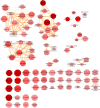Identification of novel elements of the Drosophila blisterome sheds light on potential pathological mechanisms of several human diseases
- PMID: 24968325
- PMCID: PMC4072764
- DOI: 10.1371/journal.pone.0101133
Identification of novel elements of the Drosophila blisterome sheds light on potential pathological mechanisms of several human diseases
Abstract
Main developmental programs are highly conserved among species of the animal kingdom. Improper execution of these programs often leads to progression of various diseases and disorders. Here we focused on Drosophila wing tissue morphogenesis, a fairly complex developmental program, one of the steps of which--apposition of the dorsal and ventral wing sheets during metamorphosis--is mediated by integrins. Disruption of this apposition leads to wing blistering which serves as an easily screenable phenotype for components regulating this process. By means of RNAi-silencing technique and the blister phenotype as readout, we identify numerous novel proteins potentially involved in wing sheet adhesion. Remarkably, our results reveal not only participants of the integrin-mediated machinery, but also components of other cellular processes, e.g. cell cycle, RNA splicing, and vesicular trafficking. With the use of bioinformatics tools, these data are assembled into a large blisterome network. Analysis of human orthologues of the Drosophila blisterome components shows that many disease-related genes may contribute to cell adhesion implementation, providing hints on possible mechanisms of these human pathologies.
Conflict of interest statement
Figures





References
-
- Fristrom D, Wilcox M, Fristrom J (1993) The distribution of PS integrins, laminin A and F-actin during key stages in Drosophila wing development. Development 117: 509–523. - PubMed
-
- Wilcox M, Brower DL, Smith RJ (1981) A position-specific cell surface antigen in the drosophila wing imaginal disc. Cell 25: 159–164. - PubMed
-
- Wilcox M, DiAntonio A, Leptin M (1989) The function of PS integrins in Drosophila wing morphogenesis. Development 107: 891–897. - PubMed
-
- Brower DL, Jaffe SM (1989) Requirement for integrins during Drosophila wing development. Nature 342: 285–287. - PubMed
-
- Brower DL, Piovant M, Reger LA (1985) Developmental analysis of Drosophila position-specific antigens. Developmental Biology 108: 120–130. - PubMed
Publication types
MeSH terms
LinkOut - more resources
Full Text Sources
Other Literature Sources
Molecular Biology Databases

